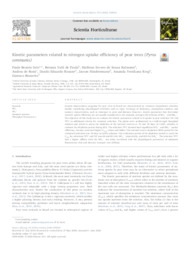Kinetic parameters related to nitrogen uptake efficiency of pear trees (Pyrus communis).
Kinetic parameters related to nitrogen uptake efficiency of pear trees (Pyrus communis).
Autoria: SETE, P. B.; PAULA, B. V. da; KULMANN, M. S. de S.; RUFATO, A. de R.; ROZANE, D. E.; HINDERSMANN, J.; KRUG, A. V.; BRUNETTO, G.
Resumo: Genetic improvement programs for pear trees in Brazil are characterized by rootstock (hypobiotic) selection mainly considering physiological attributes such as vigor, breakage of dormancy, propagation easiness, and sanitary characteristics, such as resistance to pests and diseases. However, kinetic parameters that determine nutrient uptake efficiency are not usually considered as, for example, nitrogen (N) in forms of NO3 − and NH4 +. The objective of this study was to evaluate the kinetic parameters related to N uptake in pear selection '54′ and '971′ as additional criteria for rootstock selection. The plants were acclimatized in a half-strength Hoagland solution and tested to assess the depletion of the internal reserves at 15 and 30 days, in CaSO4 solution to evaluate the depletion period during 65 h. The selection '971′ showed more significant NO3 − and NH4 + uptake efficiency, because presented higher Vmax values and Influx. The internal reserve depletion (IRD) period for the evaluated selections was 30 days in CaSO4 solution. The evaluation period of the depletion period to reach the Cmin for selections '971′ and '54′ was 64 and 65 h for NO3 − respectively, and 65 h for NH4 +. The selection '971′ had a higher affinity with the NO3 − ion when correlated with the physiological parameters of minimum fluorescence (Fo) and electron transport rate (ETRm).
Ano de publicação: 2020
Tipo de publicação: Artigo de periódico
Unidade: Embrapa Uva e Vinho
Palavras-chave: Chlorophyll fluorescence, NH4 +, NO3-, Rootstock selection
Observações
1 - Por padrão são exibidas publicações dos últimos 20 anos. Para encontrar publicações mais antigas, configure o filtro ano de publicação, colocando o ano a partir do qual você deseja encontrar publicações. O filtro está na coluna da esquerda na busca acima.
2 - Para ler algumas publicações da Embrapa (apenas as que estão em formato ePub), é necessário ter, no celular ou computador, um desses softwares gratuitos. Sistemas Android: Google Play Livros; IOS: iBooks; Windows e Linux: software Calibre.
Acesse outras publicações
Acesse a Base de Dados da Pesquisa Agropecuária (BDPA) para consultar o acervo completo das bibliotecas da Embrapa.

